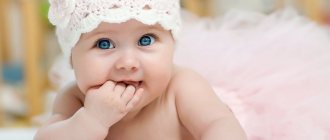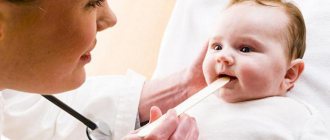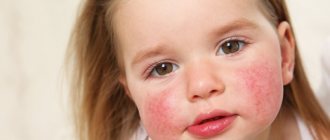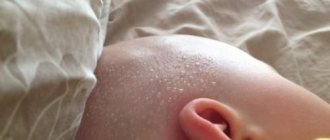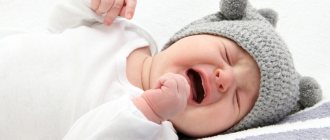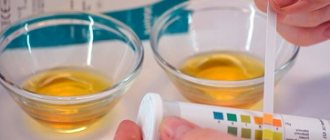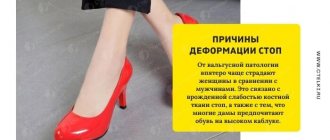Sweating - features of the mechanism
Sweating is a natural process that occurs in the body of every person. It is impossible and unnecessary to eliminate it completely, since the coordinated work of the sweat glands is of great benefit: thanks to the secretion of sweat, excess moisture, toxins and other harmful substances are released from the body.
Sweating is observed on different parts of the body, but the process is more noticeable on the armpits, soles of the feet and palms. If increased sweating occurs, it is necessary to identify its cause. It can be both physiological and pathological.
Factors
There is no need to panic prematurely. Excessive sweating can be explained by natural causes. First, you should evaluate the following factors:
- Cloth. With the best of intentions, parents try to put a lot of vests and blouses on their babies, and not only in winter. Many people believe that the newborn’s thermoregulation has not developed and he quickly freezes. This is true. But the baby also quickly overheats, as a result of which the child’s palms, head and feet sweat.
- Nutrition. If a baby overeats, his behavior becomes restless, capricious, and sweat appears. It is necessary to regulate nutrition and avoid overfeeding.
- Irritants. Sweaty palms can be caused by internal irritation and stress. During nervous overexcitation, the sweat glands receive an impulse from the nerve endings and work much more actively, which causes sweating. You should observe the baby, identify the cause and eliminate it.
- Room temperature. If a child is in an excessively dry and warm room during physical activity, his hands and feet will definitely begin to sweat. The microclimate of the nursery must be carefully monitored.
- Lack of sleep and overwork. It is important to follow a daily routine. By eliminating sleep deprivation, you can get rid of sweat.
Even when a one-year-old child’s hands are sweaty, there is no need to worry in advance. At this age, heat exchange is not fully formed, which leads to sweating. Over time, the child will grow up and the problem will go away naturally. If a child is one and a half years old or older, and his palms and feet are sweating, he needs to sound the alarm and undergo an examination. Perhaps this is a symptom of some disease.
Etiology
Sweating hands and feet in children is not a reason to panic. If the baby is a newborn, then this fact is explained by the imperfection of the thermoregulation process in the body. This is a normal phenomenon that goes away on its own with age.
This fact has a simple explanation: during intrauterine development, the body does not need to control temperature, the fetus is in the same conditions. When a child is born, he or she is faced with changes in temperature. Sweating is observed during the adaptation process.
Also, the reason why a baby’s feet are wet is the parents’ excessive care, which manifests itself in the form of a desire to provide the baby with warmth when it is not required. Mothers often wrap their children up, fearing that they will catch a cold, or create a hot climate in the house, thinking that it will be more comfortable for the baby. As a result, the child begins to sweat profusely.
Stress is also a common physiological cause of the development of hyperhidrosis. During a stressful situation, the body actively produces adrenaline, which leads to severe sweating. When experiencing stress, the first thing to sweat is your palms.
Possible pathologies
Increased sweating in the area of the baby's arms and legs may indicate the development of various diseases. After a thorough diagnosis, the following pathologies can be identified:
- VSD (vegetative-vascular dystonia);
- Heart diseases;
- Infections;
- Lymphatic diathesis;
- Rickets;
- Diabetes;
- Obesity;
- Parasitic infection;
- Muscle hypertonicity;
- Endocrine pathologies.
Why a child's palms and feet sweat - this may be due to genetic characteristics. Some inherited diseases also increase the risk of excessive sweating.
On a note!
High intracranial pressure can cause profuse sweating.
When VSD occurs in a child, the normal process of narrowing and dilation of blood vessels is disrupted. When this process becomes uncontrolled, the elasticity and strength of the circulatory system deteriorates. As a result, the baby becomes weak, dizzy, and his arms and legs sweat intensely.
Possible diseases that cause sweating in a baby
Any viral and bacterial infections affect the child’s well-being, and sweat becomes the body’s immune response to external irritants. Therefore, if intense sweating continues, it is worth measuring your body temperature and visiting a specialist.
Dr. Komarovsky believes that excessive sweating can provoke rickets. The released moisture has a characteristic smell of vinegar, the child experiences increased irritability, unreasonable whims, and sleep disturbances. In newborns with rickets, the fontanelle does not close well.
In diabetes, sweating is associated with constant changes in the chemical composition of biological fluids. Not only the composition of sweat changes, but also urine.
With diseases of the thyroid gland, sleep and appetite are disturbed. Weight gain is difficult and hand tremors appear. Sweat has an unpleasant odor and is sticky to the touch. Symptoms appear most clearly with hyperfunction of the thyroid gland.
Diseases accompanied by sweating
Among the pathologies that can provoke the development of hyperhidrosis, the following are noted:
- Vegetovascular dystonia. This condition is characterized by various manifestations associated with dysregulation of the nervous system. These include increased sweating. It occurs due to the child’s excessive activity and nervous excitability.
- Rickets. The disease occurs due to a lack of vitamin D in the baby’s body. A person receives this element to a greater extent through sunlight, and less through food. When the component is deficient, disturbances occur in the process of mineralization of bone tissue. The pathology is accompanied by unpleasant symptoms: fearfulness, irritability, mental retardation, sleep disorders, sweating.
- Infectious diseases. Colds, acute respiratory viral infections and other pathologies can cause sweat to form on the baby’s arms and legs.
- Endocrine system disorders. When the thyroid gland malfunctions, disorders occur in various organs, so immediate examination and treatment of the abnormality is required.
- Parasitic pathology. Palms and heels may be wet if the child has worms. These parasites produce waste products that the body tries to remove from the body by excreting large amounts of sweat.
It is important to eliminate infections completely, since untreated diseases pose a danger to human health.
If there are no external factors influencing the sweating process, but sweat still forms, you should visit a doctor.
Should a baby sweat?
The processes of foot sweating are natural and necessary for normal thermoregulation of the body. A newborn baby sweats just like an adult, and sometimes even more. This is due to the baby’s adaptation to new living conditions.
Sweat is produced especially heavily in the first months of life, when the baby’s body has not fully adapted. Even a slight increase in temperature or clothing that is not appropriate for the season can cause excessive sweating.
Most often, if a baby's hands and feet sweat, this is not associated with pathology. The reasons may be as follows:
- Overfeeding;
- Incorrectly introduced complementary foods;
- Wearing clothes made of synthetic materials;
- Excessive wrapping of the baby;
- Excess fluid intake or even breast milk;
- High air temperature in the children's room;
- Stress;
- Crying and screaming;
- Fright;
- Taking medications;
- Food poisoning.
On a note!
In order for the baby to feel comfortable indoors, it is important to maintain a low air temperature. Optimal conditions are 20-22 degrees Celsius.
Causes of excessive sweating in babies
The level of sweating of a child's feet is due to a hereditary predisposition. When parents are prone to excessive sweating, there is a high probability that their baby will encounter this problem in the first months of life.
If you carefully observe your child, you can quickly understand why your baby's feet and hands are sweating. It is worth paying attention to the nature and smell of sweat. If the baby’s feet, legs, forehead and body become moist at the same time, and at this moment no unpleasant odor appears, then there are no health problems. But if there were no mistakes in keeping the baby, and sweat comes out again and again for no reason, you should consult a doctor for advice.
Diagnostics
To find out the reason for the formation of sweat on the palms and feet of a child, an examination is required. It is performed using the following methods:
- Study of sweat secretions.
- Blood test for general clinical and biochemical parameters, sugar, hormones, infections.
- Analysis of urine.
- Ultrasound examination of the thyroid gland.
If necessary, the doctor prescribes additional diagnostic methods. In each case, the list of examinations is compiled on an individual basis.
Ways to eliminate hyperhidrosis
If a child’s hands and feet are sweaty for physiological reasons, you just need to eliminate them, and the process of sweat formation will normalize on its own. Parents should set the optimal air temperature in the room - no more than 22 degrees, and ensure the required humidity level of 60%.
It is also important to take children out into the fresh air every day, carry out water treatments, and change their linen. If sweating is a consequence of increased activity of the child, it is recommended to take herbal remedies that calm the nervous system.
If hyperhidrosis develops as a result of any pathology, then you should first address it. In this case, treatment tactics are selected individually depending on the identified disease.
Treatment
If the reasons behind the increased moisture in the palms and feet of the baby have been established, then the correct treatment can begin, which is developed by the doctor, taking into account the individual characteristics of the baby’s body, or the identified pathologies. You can also fight this disease by practicing the following techniques:
- Regular hygiene procedures. It is important here that both children and adults in the same family develop the habit of regularly performing hygiene procedures: washing their hands and feet, taking a shower, brushing their teeth. For these purposes, it is better to use soap with antiseptic additives, which is offered by pharmacies. Also, when bathing your baby in the bath, you need to add a chamomile decoction to the water. After all, this plant is a natural antiseptic that does not cause allergic reactions. You can also use decoctions of mint, oak bark or sage.
- Wear underwear and socks only from natural materials. The child's body, including the skin, does not tolerate constant contact with synthetics. Therefore, you should give preference to linen or cotton socks, and dress according to the season (you don’t need to put winter socks and warm underwear with a hat on your newborn in the summer).
- Room temperature control. If you have a newborn at home, then you need to monitor the temperature. Ideally, the room should be approximately +20, with a relative humidity of 60%.
- Hardening the body. We are not talking about diving into an ice hole in winter, or dousing yourself with water in the cold. Enough with daily walks (including in winter) in the fresh air. This way the body quickly adapts to changes in temperature and environmental influences.
- Foot massage. To prevent the baby's feet from sweating, parents can regularly perform massage procedures (stroking and pinching while bathing).
- No stress. A child should grow up in a favorable emotional environment. To create it, you need to constantly talk with babies and older children, and not neglect kisses and caresses.
- Control of the child's mobility. Modern children grow up hyperactive, which is why they often suffer from increased moisture in their palms and feet. You should keep him busy with calm games.
- Prevention of rickets. You can prevent the development of such a terrible disease by saturating your baby’s body with the necessary amount of vitamin D.
Doctors also note that children who are bottle-fed or breast-fed and who are under three months old, but who receive proper nutrition, may have increased moisture in their palms and feet.
If parents often walk with the baby, he is not capricious, and feels great, then there is nothing to worry about in this situation. This phenomenon only indicates the development and strengthening of the nervous system, adaptation to the surrounding world. If there are suspicions or doubts about the child’s health, it is better to consult a doctor rather than self-medicate. Share:
Prevention
The following recommendations will help prevent the development of hyperhidrosis in children:
- Personal hygiene. You can add herbal decoctions and infusions to the baths.
- Daily linen change.
- Refusal of synthetic clothing.
- Regular exposure to fresh air.
- Strengthening the immune system.
- Proper nutrition.
- Maintaining the air temperature in the apartment no more than 22 degrees and a humidity level of 60%.
If signs of rickets, endocrine system disorders or other pathologies occur, you should consult a doctor as soon as possible.
Pathological causes and their elimination
Secondary hyperhidrosis is a nonspecific symptom, and there are a lot of diseases that accompany it; it’s impossible to list them all in a short article. Of course, now we are only concerned with those that occur in the baby. This is rickets. The reason is a lack of vitamin D and sunlight, so infants living in northern latitudes are most susceptible to it.
What foods contain vitamin D?
In such babies, the fontanelles cannot close for an extremely long time, up to 5 months. The baby is overly capricious, emotionally unstable and fearful, even too bright light makes him cry, his feet and legs are wet, and his sweat glands are open. Children suffer from insomnia and loss of appetite, and begin to develop more slowly than their peers. Hyperhidrosis is general, that is, it covers the entire body, and not just the legs or armpits. The sweat is sticky and sour.
When the baby still manages to sleep, he begins to develop hyperhidrosis of the head, especially the back of the head. While dozing, the child begins to rub his head on the bed, which causes specific alopecia (bald patch) to form on the back of his head. Subsequently, deformation of the legs in the shape of the letter X or O is observed, and this symptom remains for life, making the child disabled, so do not delay treatment.
Without treatment, the legs will become deformed in the shape of the letter X or O
ARVI, tonsillitis, and flu are accompanied by an increase in body temperature, which is why you always break into a sweat. In addition, bacterial toxins and remnants of destroyed microorganisms are eliminated with sweat. A disease that is not too severe does not require specific treatment, but do not forget about possible complications and consult a doctor whenever alarming symptoms appear. By the way, don’t even try to lower your newborn’s temperature with aspirin; it can cause Reye’s syndrome, an extremely dangerous complication of the liver. Paracetamol or Nurofen will do.
To ensure that your baby suffers from acute respiratory viral infections and bacterial colds as little as possible, thoroughly ventilate the room, do not wrap the child too tightly, walk in the fresh air, and make sure he eats properly. Don’t worry if excessive sweating continues for some time after recovery, this is normal. The body's thermoregulation systems need to return to normal.
Failures in the functioning of the endocrine glands cause an imbalance in all regulatory systems. They are accompanied by increased sweating of the feet and hands, fever, anxiety, the baby does not gain weight well and sleeps restlessly.
httpv://www.youtube.com/watch?v=embed/ezMf18sgsLs
Diabetes mellitus also causes hyperhidrosis in young children, both local - arms and legs, and general. The skin suffers greatly from diaper rash. The urine becomes so sticky that the diapers appear starched. The child suffers from increased thirst and does not gain weight well. If you notice such signs in your baby, donate blood for sugar. Diagnosis and treatment must begin as early as possible.

